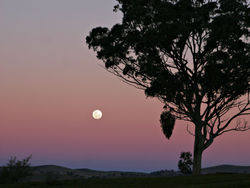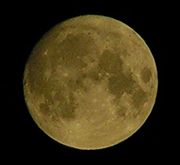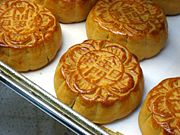The Mid-Autumn Festival, also known as the Moon Festival, is a popular East Asian tradition of Chinese origin, dating back over 3,000 years to moon worship in China’s Shang Dynasty, that spread to neighbouring cultures like Japan. It was first called Mid-Autumn festival in the Zhou Dynasty. In Malaysia and Singapore, it is also sometimes referred to as the Lantern Festival or Mooncake Festival. In both South Korea and North Korea, the festival is called chuseok as a harvest festival, and is the biggest public holiday.
Stories of the Mid-Autumn Festival 
Houyi and Chang’e
While Westerners may talk about the “man in the moon”, the Chinese talk about the “woman in the moon”. The story of the fateful night when Chang’e was lifted up to the moon, familiar to most Chinese citizens, is a favorite subject of poets. Unlike many lunar deities in other cultures who personify the moon, Chang’e lives in the moon. Tradition places Houyi and Chang’e around 2170 BC, in the reign of the legendary Emperor Yao, shortly after that of Huang Di.
There are so many variations and adaptations of the Chang’e legend that one can become overwhelmed and utterly confused. However, most legends about Chang’e in Chinese mythology involve some variation of the following elements: Houyi, the Archer; Chang’e, the mythical Moon Goddess of Immortality; an emperor, either benevolent or malevolent; an elixir of life; and the Moon.
Houyi, the archer
Houyi was an immortal, while Chang’e was a beautiful young girl, working in the Jade Emperor’s (Emperor of Heaven) (玉帝 pinyin:yùdì) Palace as the attendant to the Queen Mother of the West (wife of the Jade Emperor), just before her marriage. One day, Houyi aroused the jealousy of the other immortals, who then slandered him before the Jade Emperor. Houyi and his wife, Chang’e, were subsequently banished from heaven, and forced to live by hunting on earth. He became a famous archer.
 Now at this time, there were 10 suns, in the form of Three-legged birds, residing in a mulberry tree in the eastern sea; each day one of the sun birds would have to travel around the world on a carriage, driven by Xihe (deity) the ‘mother’ of the suns. One day, all 10 of the suns circled together, causing the earth to burn. Emperor Yao, the Emperor of China, commanded Houyi to shoot down all but one of the suns. Upon the completion of his task, the Emperor rewarded Houyi with a pill that granted eternal life, and advised him: “Make no haste to swallow this pill; first prepare yourself with prayer and fasting for a year”. Houyi took the pill home and hid it under a rafter, while he began healing his spirit. While Houyi was healing his spirit, Houyi was summoned again by the emperor. Chang’e, noticing a white beam of light beckoning from the rafters, discovered the pill, which she swallowed. Immediately, she found that she could fly. At that moment, Houyi returned home, and, realizing what had happened, began to reprimand her. Chang’e flew out the window into the sky.
Now at this time, there were 10 suns, in the form of Three-legged birds, residing in a mulberry tree in the eastern sea; each day one of the sun birds would have to travel around the world on a carriage, driven by Xihe (deity) the ‘mother’ of the suns. One day, all 10 of the suns circled together, causing the earth to burn. Emperor Yao, the Emperor of China, commanded Houyi to shoot down all but one of the suns. Upon the completion of his task, the Emperor rewarded Houyi with a pill that granted eternal life, and advised him: “Make no haste to swallow this pill; first prepare yourself with prayer and fasting for a year”. Houyi took the pill home and hid it under a rafter, while he began healing his spirit. While Houyi was healing his spirit, Houyi was summoned again by the emperor. Chang’e, noticing a white beam of light beckoning from the rafters, discovered the pill, which she swallowed. Immediately, she found that she could fly. At that moment, Houyi returned home, and, realizing what had happened, began to reprimand her. Chang’e flew out the window into the sky.
With a bow in hand, Houyi sped after her, and the pursuit continued halfway across the heavens. Finally, Houyi had to return to the Earth because of the force of the wind. Chang’e reached the moon, and breathless, she coughed. Part of the pill fell out from her mouth. Now, the hare was already on the moon, and Chang’e commanded the animal to make another pill from it, so that she could return to earth to her husband.
As of today, the hare is still pounding herbs, trying to make the pill. As for Houyi, he built himself a palace in the sun as “Yang” (the male principle), with Chang’e as “Yin” (the female principle). Once a year, on the 15th day of the full moon, Houyi visits his wife. That is why, that night, the moon is full and beautiful.
The Hare – Jade Rabbit
According to tradition, the Jade Rabbit pounds medicine, together with the lady, Chang’e, for the gods. Others say that the Jade Rabbit is a shape, assumed by Chang’e herself. You may find that the dark areas to the top of the full moon may be construed as the figure of a rabbit. The animal’s ears point to the upper right, while at the left are two large circular areas, representing its head and body.
In this legend, three fairy sages transformed themselves into pitiful old men, and begged for food from a fox, a monkey, and a hare. The fox and the monkey both had food to give to the old men, but the hare, empty-handed, jumped into a blazing fire to offer his own flesh instead. The sages were so touched by the hare’s sacrifice and act of kindness that they let him live in the Moon Palace, where he became the “Jade Rabbit”.

The Mid-Autumn Festival falls on the 15th day of the 8th lunar month of the Chinese calendar (usually around mid- or late-September in the Gregorian calendar), a date that parallels the Autumn and Spring Equinoxes of the solar calendar. The traditional food of this festival is the mooncake, of which there are many different varieties.
The Mid-Autumn Festival is one of the two most important holidays in the Chinese calendar (the other being the Chinese Lunar New Year), and is a legal holiday in several countries. Farmers celebrate the end of the summer harvesting season on this date. Traditionally, on this day, Chinese family members and friends will gather to admire the bright mid-autumn harvest moon, and eat moon cakes and pomeloes together. Accompanying the celebration, there are additional cultural or regional customs, such as:
Eating moon cakes outside under the moon
Carrying brightly lit lanterns, lighting lanterns on towers, floating sky lanterns
Burning incense in reverence to deities including Chang’e
Planting Mid-Autumn trees
Collecting dandelion leaves and distributing them evenly among family members
Fire Dragon Dances
Source: en.wikipedia.org




